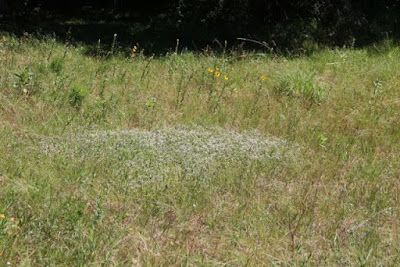 |
| back yard "invaded" by a bull thistle
Photo by J. Harrington
|
The bull thistle we noticed in back hasn't yet bloomed. I need to work on pulling it sometime this week. I'd take the chain saw to it but that would leave the tap root and, from what I've read, it would then be back next year. I'll try the planting spade to dig it out. If I had noticed it sooner, it would have been the perfect excuse to get the hori hori I've had my eye on, but it's way beyond that stage of growth. Of course, if I follow what seems to be the perspective of the author of The New Wild, I could try benign neglect as a management approach. I'm about half way through the book on"why invasive species will be nature's salvation" and have thoroughly confirmed my bias that we humans don't really know what we're doing when we try to manage nature.
 |
| Black-eyed Susans behind feral oregano
Photo by J. Harrington
|
An example right here at home comes from my observation that none of this year's, or last year's, plantings of prairie flowers seem to have survived on the sandy side hill, just as almost none of the wildflower seeds we've sown over the years have germinated and grown. The one exception is (are?) the Black-eyed Susan seeds the Better Half collected and scattered last year. We now have a number of yellow splotches adding color to the pale lilac feral oregano that's blooming and continues to take over much of the North and East sides of the side hill.
Leopold uses broad and expansive definitions of "community" as he writes of a land ethic. This seems to me to imply that a community is not a closed system. That, in turn, raises some interesting considerations about what we mean by native, indigenous, invasive, naturalized and, even, how to think about what a bioregion is. Can we have communities that aren't parochial, that aren't hostile to invasive others? Can we create a culture that isn't based on colonialism and doesn't depend on global capitalism? As Rodney King said "Can we all get along?"
The People of the Other Village
By Thomas Lux
hate the people of this villageand would nail our hatsto our heads for refusing in their presence to remove themor staple our hands to our foreheadsfor refusing to salute themif we did not hurt them first: mail them packages of rats,mix their flour at night with broken glass.We do this, they do that.They peel the larynx from one of our brothers’ throats.We devein one of their sisters.The quicksand pits they built were good.Our amputation teams were better.We trained some birds to steal their wheat.They sent to us exploding ambassadors of peace.They do this, we do that.We canceled our sheep imports.They no longer bought our blankets.We mocked their greatest poetand when that had no effectwe parodied the way they dancewhich did cause pain, so they, in turn, said our Godwas leprous, hairless.We do this, they do that.Ten thousand (10,000) years, ten thousand(10,000) brutal, beautiful years.
********************************************
Thanks for visiting. Come again when you can.
Please be kind to each other while you can.
No comments:
Post a Comment